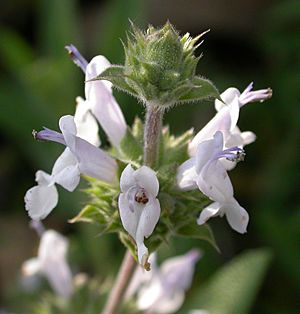Seel facts for kids
Quick facts for kids Seel |
|
|---|---|
 |
|
| Scientific classification |
Salvia mellifera is a small, evergreen shrub known as black sage. Some people, like the Mahuna, call it seel. This plant is part of the Salvia family, which includes many types of sages.
Black sage grows naturally in California and Baja California, Mexico. You can often find it in the coastal sage scrub areas of Southern California and northern Baja California. It tends to look dark, especially when there isn't much rain.
Contents
What Black Sage Looks Like
Black sage is a plant that lives for many years, called a perennial shrub. It usually grows about 3 to 6 feet (1 to 2 meters) tall. The plant is covered in tiny hairs, some of which are sticky and release a strong, pleasant smell.
Its leaves are shaped like long ovals, about 1 to 3 inches (2.5 to 7 cm) long. The top of the leaves is fairly smooth, while the bottom is hairy.
Flowers and Fruit
The flowers of the black sage grow in clusters that are about 0.6 to 1.6 inches (1.6 to 4 cm) wide. They are usually a light blue or lavender color. Sometimes, you might see rare pale pink flowers.
The top part of the flower has two small lobes. The stamens (which hold pollen) and the style (which receives pollen) stick out a little. After the flowers, the plant makes a fruit called a schizocarp. This fruit is made of four small, brown, nut-like seeds, each about 0.08 to 0.12 inches (2 to 3 mm) long.
Where Black Sage Grows
Black sage thrives in coastal sage scrub and lower chaparral plant areas. It can grow from sea level up to about 3,900 feet (1,200 meters) high.
This plant is very adaptable and can grow in many different types of soil. These include sandstone, shale, granite, and even volcanic rocks like gabbro or basalt.
How It Handles Dry Weather
Black sage is good at living in dry places. It has shallow roots and can handle droughts well. Instead of dropping its leaves to save water, it often curls them up. Depending on where it grows and how bad the drought is, it might lose some of its leaves, but not all of them.
Plant Hybrids
Black sage can easily mix with other coastal Salvias to create new types of plants. These include Salvia apiana (white sage), Salvia leucophylla, and Salvia clevelandii. It rarely mixes with annual plants like Salvia columbariae and Salvia carduacea.
Traditional Uses
The Chumash people, a Native American group, used black sage for medicine. They would make a strong tea from the leaves and stems of the plant. This tea was then rubbed on sore body parts or used to soak aching feet.
Black sage contains natural chemicals like diterpenoids and ursolic acid. These chemicals are known to help relieve pain.
Black Sage Honey
Black sage flowers produce a sweet liquid called nectar. Bees collect this nectar to make a special kind of honey called Black Sage honey. This honey often has a strong, peppery taste.
It is considered a rare and valuable honey because the black sage plant grows in dry areas. The plant only produces enough nectar for honey when there has been just the right amount of rain.
See also
 In Spanish: Salvia mellifera para niños
In Spanish: Salvia mellifera para niños

